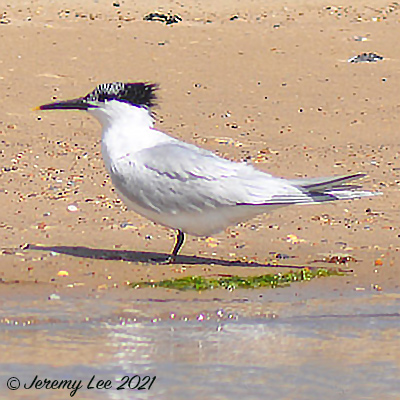
 |
|
Scientific Classifications explained » Amphibians » Ants » Aphids » Bees » Beetles » Birds » Bugs » Butterflies » Caterpillars » Damselflies » Dragonflies » Earwigs » Flies » Frog/Leafhoppers » Fungi » Galls » Grasshoppers » Harvestmen » Hoverflies » Lacewings » Ladybirds » Leaf Mines » Lichens » Mammals » Millipedes » Mosses » Moths » Sawflies » Slugs » Snails » Spiders » Trees & Shrubs » Wasps » Wild Flowers » Woodlice » Postboxes |
UK Nature > Birds > Sterna sandvicensis

Scientific Name: Sterna sandvicensis Common Name: Sandwich Tern Sterna sandvicensis, more commonly known as the Sandwich Tern, is a very white tern, with a black cap on its head, a long black bill with a yellow tip and short black legs. In flight it shows grey wedges on its wings tips and it has a short forked tail. The individual in the above photograph is in transition between breeding and non-breeding plumage; the black cap is turning gradually to white at the front, by the bill. In the UK, many of the important colonies survive because they are on nature reserves. There are colonies of Sandwich terns scattered around the UK coasts including the North Norfolk coast; Minsmere, Suffolk; and Dungeness, Kent. They can be seen from late March to September, usually feeding on fish such as sand eels, sprats and whiting. There are about 12000 breeding pairs in the UK. |
|

https://www.uknature.co.uk is a website dedicated to showing the immense diversity of UK nature and wildlife. Our vast range of habitats, from lowland arable to snow covered mountains, from storm-ravaged coastlines to peaceful inland freshwater lakes and rivers, from dry, sandy heaths to deciduous and coniferous forests, all these habitats contribute to the abundance of UK nature. We have wild birds in huge numbers either residing or visiting our shores (597 recorded species as at July 2013) and we must also not forget the humble back garden with its grass lawns, flower beds filled with nectar rich flowers, shrubs and trees, all designed to attract huge numbers of insects such as bees, moths, butterflies and hoverflies; and finally the small ponds which provide safe havens for frogs, toads, newts and even slow worms and grass snakes. www.uknature.co.uk is the showcase for my personal passion, photographing uknature in all its glory. I sincerely hope you all enjoy the fruits of my labours. This site and all images contained therein is © Jeremy Lee 2004 - 2025. All Rights Reserved. Site design by Jeremy Lee. Site development & IT Support by Stuart Lee. |